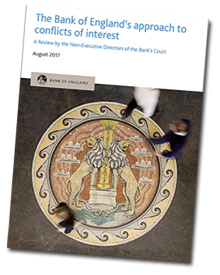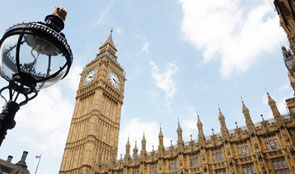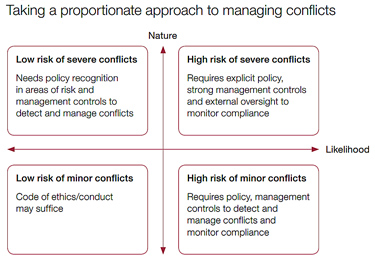 High profile incidents remind individuals and organisations just how important it is to manage potential conflicts of interest. In March 2017, the Court of the Bank of England commissioned a review of the institution’s approach to managing conflicts of interest. The review was prompted by the resignation of Charlotte Hogg who had been Deputy Governor for Markets and Banking. A report from the House of Commons Treasury Select Committee published in March 2017 had raised concerns about her compliance with the Bank’s rules governing conflicts of interest. As part of its Review the Bank invited the NAO to contribute a briefing paper on managing conflicts of interest. It’s a timely opportunity for the whole public sector to consider whether it’s managing conflicts of interest effectively.
High profile incidents remind individuals and organisations just how important it is to manage potential conflicts of interest. In March 2017, the Court of the Bank of England commissioned a review of the institution’s approach to managing conflicts of interest. The review was prompted by the resignation of Charlotte Hogg who had been Deputy Governor for Markets and Banking. A report from the House of Commons Treasury Select Committee published in March 2017 had raised concerns about her compliance with the Bank’s rules governing conflicts of interest. As part of its Review the Bank invited the NAO to contribute a briefing paper on managing conflicts of interest. It’s a timely opportunity for the whole public sector to consider whether it’s managing conflicts of interest effectively.
What are conflicts of interest?
A conflict of interest is a set of circumstances that creates a risk that an individual’s ability to apply judgement or act in one role is, or could be, impaired or influenced by a secondary interest. It can occur in any situation where an individual or organisation (private or government) can exploit a professional or official role for personal or other benefit. The perception of competing interests, impaired judgement or undue influence can also be a conflict of interest.
A principled approach
 The UK has a ‘principles-based approach’ to conflicts of interest. Rather than specific legislation, as in the USA, behavioural and ethical standards are defined in codes of conduct. Civil servants are expected to act with “integrity” and board members are expected to declare and record conflicts of interest.
The UK has a ‘principles-based approach’ to conflicts of interest. Rather than specific legislation, as in the USA, behavioural and ethical standards are defined in codes of conduct. Civil servants are expected to act with “integrity” and board members are expected to declare and record conflicts of interest.
Although the principles are clear, the process for managing declared conflicts of interest and the way policies and guidance are framed are matters for individual organisations. This is why we were happy to provide this briefing, Contribution to Bank of England: Review Managing potential conflicts of interest, drawing on our earlier Conflict of interest report. We’re now delighted to share it more widely following publication of the Bank’s own Review of the Bank of England’s approach to identifying and managing conflicts of interest.
 Conflicts of interest are a normal and unavoidable part of decision-making and seeking to eliminate them is neither feasible nor desirable. At the same time, for all public bodies, it is essential to maintain public trust and confidence in the organisation and individuals. In such a relationship with the public, it is important for institutions to consider the perceived, and not solely the actual, conflicts that may be present.
Conflicts of interest are a normal and unavoidable part of decision-making and seeking to eliminate them is neither feasible nor desirable. At the same time, for all public bodies, it is essential to maintain public trust and confidence in the organisation and individuals. In such a relationship with the public, it is important for institutions to consider the perceived, and not solely the actual, conflicts that may be present.
To ensure public confidence, public servants need not only to act with integrity, but to be seen to be doing so. When a conflict of interest is exposed, it can lead to organisational reputational damage, bring decision‑making into disrepute, and could result in a legal challenge. For the individual, some conflicts can result in criminal action, for example fraud, bribery or corruption through abuse of position.
So how do conflicts of interest arise? What conflict of interest risks must organisations manage? How can individuals and organisations prevent, detect and address conflicts of interest?
Types of conflicts of interest
Conflicts of interest can arise from a range of issues and many of them are illustrated by our investigations into specific situations and into the systemic risk of conflicts of interest. As explained in our previous post, NAO investigates, our investigations set out the facts of a situation, rather than drawing a conclusion.
Pecuniary interest: either a direct or indirect financial interest, or a financial interest held by a commercial undertaking by which the individual has connections. For example, an individual holds shares in an entity that could be affected by a policy issue on which they are working. Even past shareholdings can raise concerns, as the example below shows.
Procurement interest: where individuals have relationships with a company that has or may bid for work.
Example: Managing past company shareholdings
Our Investigation: The Department for Education’s (DfE) management of a potential conflict of interest followed concerns about the relationship between DfE’s Chief Social Worker for Children and Families and a company called Morning Lane Associates. Before joining DfE, the Chief Social Worker had been a director and shareholder in the company, which had provided services to local authorities, but had no contracts with DfE. After the Chief Social Worker’s appointment, the company secured four contracts worth about £2.9 million with DfE. In setting out the facts of this case, our report highlights the importance of ensuring that potential conflicts of interest are managed, and seen to be managed, appropriately.
Personal relationships: close relationships with a person or people who engage in some way with the institution for which they work.
Example: Failure to disclose caused high-profile resignation
This was the case with the Charlotte Hogg, the Bank of England’s newly-appointed Deputy Governor (which added to her responsibility as Chief Operating Officer), who admitted that she had not disclosed that her brother held a position at Barclays, a Bank of England regulated firm. Failure to make this disclosure was in breach of the Bank’s code of conduct, which she had helped to write. It led to the Treasury select committee publishing a highly critical report and Charlotte Hogg’s resignation.
 Acceptance of gifts and hospitality: Generally, low-value gifts are acceptable, but not higher-value gifts. Some judgement needs to be exercised by individuals and organisations, and this can be confusing.
Acceptance of gifts and hospitality: Generally, low-value gifts are acceptable, but not higher-value gifts. Some judgement needs to be exercised by individuals and organisations, and this can be confusing.
 Political interests: The boundaries of civil servants’ involvement in political activities are set out for departments and agencies in Section 4.4 of the Civil Service management code: November 2016. This code specifies, for different staff grades, the extent to which they can be involved in national and local political activities in a personal capacity. It sets out the guidelines and principles, but, again, leaves departments and agencies discretion as to what political permissions are allowed to ensure that the institution is politically neutral, and perceived to be so.
Political interests: The boundaries of civil servants’ involvement in political activities are set out for departments and agencies in Section 4.4 of the Civil Service management code: November 2016. This code specifies, for different staff grades, the extent to which they can be involved in national and local political activities in a personal capacity. It sets out the guidelines and principles, but, again, leaves departments and agencies discretion as to what political permissions are allowed to ensure that the institution is politically neutral, and perceived to be so.
Employment interest: Potential conflicts can arise during recruitment, when staff have additional outside interests and when staff move on to other roles
Recruiting staff needs to involve transparent processes and criteria to ensure decisions are made objectively and without bias.
Additional, outside employment and external roles as non-executive directors are often subject to restrictions, depending on the nature of the work carried out and actual or perceived conflicts.
Inward and outward secondment programmes can create the possibility of conflicts, and procedures should explicitly consider the risk of creating an actual or perceived conflict.
The prospect of future employment also carries risks:
- Before leaving government, an official may abuse his/her office to shape a policy or decision to the benefit of a certain company.
- After leaving, the individual may take advantage of his/her relationship with former government colleagues to exert undue influence on their decisions.
- An individual could take advantage of privilege knowledge gained within government, either to profit financially or to use information to take a role opposing government.
 The Cabinet Office is responsible for the Business Appointment Rules (the Rules) that apply to all civil servants who leave the civil service and move to employment in other sectors. Our recent Investigation into government’s management of the Business Appointment Rules found that departments were not consistently applying the Rules, the centre of government has no oversight of departmental compliance with the rules, and that no department has assurance that former civil servants remained compliant with the Rules.
The Cabinet Office is responsible for the Business Appointment Rules (the Rules) that apply to all civil servants who leave the civil service and move to employment in other sectors. Our recent Investigation into government’s management of the Business Appointment Rules found that departments were not consistently applying the Rules, the centre of government has no oversight of departmental compliance with the rules, and that no department has assurance that former civil servants remained compliant with the Rules.
Example from ‘Conflicts of interest’: Employing relatives resulted in resignation and police investigation
In 2012 a Department for Education (DfE) investigation into the Priory Federation of Academies found a history of relatives of staff being employed and engaged as consultants. The CEO resigned and was subject to police investigation. Source: Investigation Report on Priory Federation of Academies Trust, Department for Education, March 2012.
Preventing, detecting and addressing conflicts of interest
 Good practice in managing conflicts of interest is set out in our report Conflict of interest (and summarised in Appendix Two). An organisation’s approach will depend on the level of risk and its potential consequences. Generally, all public sector organisations should:
Good practice in managing conflicts of interest is set out in our report Conflict of interest (and summarised in Appendix Two). An organisation’s approach will depend on the level of risk and its potential consequences. Generally, all public sector organisations should:
- Promote ethical standards.
- Ensure their staff understand conflicts of interest and know how to identify and report them.
- Be transparent, including having arrangements to declare and register gifts and other benefits.
- Get all staff and contractors to declare routinely all private, personal and financial interests relevant to decision-making, management of contracts and giving policy advice.
- Have proportionate oversight and detection mechanisms, which may include external arrangements, such as external audit and regulator checks; and reporting systems, such as whistleblowing arrangements.
- Have proportionate, enforceable sanctions for non-compliance, including personal consequences (such as disciplinary action, dismissal or prosecution) and management actions (for example, retroactive cancellation of a decision or contract).
A number of our studies illustrate the importance of public bodies having strong oversight to ensure arrangements are in accordance with policies and deliver good value for money.
Example: Weak departmental oversight risked public money
Our Investigation into potential conflicts of interest in the award of Disabled Students’ Allowance (DSA) examined the arrangements for disabled students at Plymouth University whose support requirements were assessed by an assessment centre on campus. After concerns were raised, we looked at whether there were potential conflicts of interest between the assessment centre and the operator providing support; whether the relationships had an impact on value for money for taxpayers; and whether a larger than expected proportion of students at Plymouth University received DSA.
We found that the department had not taken sufficient action to mitigate fully the risk of a conflict of interest, and that its weak oversight meant it had failed to detect that the assessment practice was awarding the maximum support students might need, rather than the most likely level of support, as was normal practice elsewhere. By the time our investigation set out the facts of what had happened, the management and oversight processes had been tightened up.
We have also investigated situations where no specific conflict of interest has been reported, but where the whole structure or system carries heightened risk of conflicts of interest, creating a strong need for effective management and assurance systems.
Example: Ensuring assurance in situations of high systemic risk of conflicts of interest
Reforms in 2012 created a new clinically-led local NHS commissioning system in which around 200 clinical commissioning groups (CCGs) make decisions about local health services and funding levels, controlling around two-thirds of the NHS commissioning budget. All GP practices are members of their local CCG and some GPs sit on their CCG’s governing body. The Department of Health (DH) recognised that the new arrangements increased the potential for significant conflicts of interest, but felt that the risks could be managed and were justified by the expected benefits of the new system.
In Managing conflicts of interest in NHS clinical commissioning groups we investigated whether the arrangements were sufficient to safeguarding patients’ interests and taxpayers’ money and concluded that DH took a proportionate response to the high potential risk and that CCGs generally appeared to have arrangements for managing conflicts of interest. These arrangements rely on both personal integrity and local transparency. To promote greater public confidence in the system we made recommendations about improving transparency and assurance processes, for DH, NHS England, Monitor (now working within NHS Improvement) and CCGs.
Internal Drainage Boards is a similar example of the need for strong oversight and assurance to reduce the systemic risk of conflicts of interest.
Internal Drainage Boards is a similar example of the need for strong oversight and assurance to reduce the systemic risk of conflicts of interest.
Reporting a conflict of interest
Organisations should ensure their staff know how to report conflicts of interest. In general terms, this includes:
- Talk to your line manager or someone else in your line management chain.
- Raise the matter with your department’s nominated officers who have been appointed to advise staff on their code of conduct.
- If there’s evidence of criminal or unlawful activity, it should be reported to the police or other appropriate regulatory authorities.
- If you have raised a matter in accordance with the relevant procedures and do not receive what you consider to be a reasonable response, you may report the matter to the Civil Service Commission, email: info@csc.gov.uk
- You may also raise the concern with the NAO, via our contact form.
Having the flexibility to adapt guidance and processes to an individual organisation’s circumstance has many benefits, but it also puts much greater responsibility on those organisations. We hope that our past studies help to illustrate the potential risks that both organisations and individuals face and the approach that public bodies need to take to prevent, detect and address conflicts of interest.
We are always happy to help organisations by sharing our cross-government insight, such as through our Contribution to Bank of England: Review Managing potential conflicts of interest. Should you wish to discuss this, or any issue, please don’t hesitate to contact us. We also invite your comments on the crucial matter of public sector integrity.




